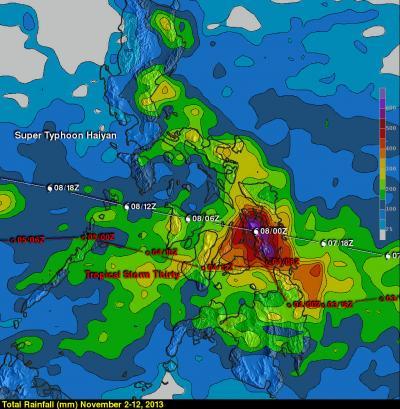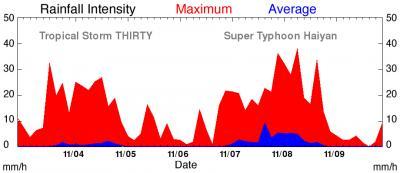Haiyan, known locally in the Philippines as Yulonda, will go down as a historic storm, making landfall in the central Philippines as perhaps the most powerful tropical cyclone to ever make landfall with sustained winds estimated at 195 mph (~315 kph). So far, over 2300 people are confirmed to have been killed by the storm, and the number is likely to climb higher with many still missing and not all areas unaccounted for. Katrina, which devasted the US Gulf coast in 2005, was responsible for 1833 fatalities.
The most deadly flooding from Super Typhoon Haiyan was caused by the storm surge, which was reported to be up to 5.2 meters (~17 feet) in Tacloban, located on the northeast tip of Leyte, where the strong cyclonic winds from Haiyan funneled water into the northwest corner of Leyte Gulf between the islands of Leyte and Samar.

The combined rainfall from these tropical cyclones is shown in this image during the period from Nov. 2-12, 2013.
(Photo Credit: Hal Pierce, SSAI/NASA GSFC)
In addition to the fierce winds and powerful surge, Haiyan brought copious amounts of rainfall to the central Philippines along with Tropical Storm Thirty and another tropical disturbance (90w), which all passed through the the central Philippines within in the past ten days. The combined rainfall from these tropical cyclones (first image to the right) in the TRMM-based, near-real time Multi-satellite Precipitation data (TMPA) analysis shown above during the period from November 2-12, 2013. It shows that most of the island of Leyte had rainfall totals greater than 500mm (~19.7 inches, dark red) with a peak amount of over 685 mm (~27 inches, lighter purple) located over the southeast corner of the island.
Peak and average rainfall over the central Philippines (second image to the right) shows that despite being far less intense, Tropical Storm Thirty, which preceded Super Typhoon Haiyan by about three days, produced similar peak rain intensities (shown in red) and over a similar duration, but less average rainfall (shown in blue) than Haiyan.

Peak and average rainfall over the central Philippines shows that despite being far less intense, Tropical Storm Thirty, which preceded Super Typhoon Haiyan by about three days, produced similar peak rain intensities (red) and over a similar duration, but less average rainfall (blue) than Haiyan.
(Photo Credit: Image : Hal Pierce, SSAI/NASA GSFC)
Source: NASA/Goddard Space Flight Center